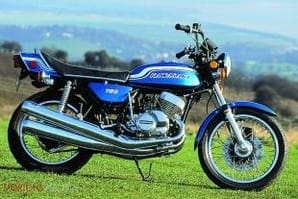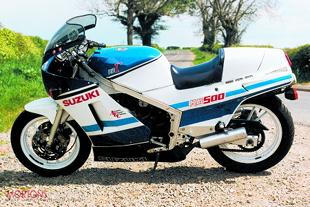
10 1972 Kawasaki H2 750
All the vices and perverse virtues of its Mach III forerunner in 750cc form. Although no faster than the Mach III 500, it was a shade quicker over the standing-quarter and the difference was enough for it to claim the title of the fastest accelerating production bike of its day.
There were four versions. The original 1972 model was followed by the 1973 H2A, 1974 H2B and 1975 H2C. Significant chassis changes in 1974 didn’t improve the handling that much and a bid to smother the motor’s considerable high rpm vibration was inexplicably abandoned after the appearance of only a handful of ’74 machines with rubber cushioning in the engine mounts.
As with the 500, each of the 750 models was slightly less powerful than its predecessor. However, unlike the 500, they are all highly rated and many consider the 112 mph ‘long tank’ H2C the pick of the bunch on looks alone.
Engine: 748cc aircooled triple, piston port induction Weight: 422 lb Power: 74 bhp at 6800 rpm Speed: 120+mph.
9 1976 Yamaha RD400
The RD400 is arguably the best aircooled twin cylinder two stroke ever. It’s certainly the most fun – a lithe, wheelie-popping, six-speed giant-killer that could run rings round much bigger capacity bikes. With a little light tuning it became a rocketship.
It was Yamaha’s final aircooled two stroke twin and could trace its ancestry back to the 1959 YDS1, via the 1967 YR5 and the 1972 RD350.
In terms of historical significance, the YR5 and RD350 should take precedence, but the extra capacity squeezed from the RD350’s reed-valve motor gave the 400 more punch and increased the smile factor.
The last of the RD400s was the 1979 400F Daytona Special – an American-market model that employed air valves in the exhaust to help meet EPA emission regulations. Although never sold in Britain, the Daytona’s superb styling is reason enough to track one down.
Engine: 398cc aircooled parallel twin, reed valve induction Weight: 346 lb Power: 40 bhp at 7000 rpm Speed: 105 mph
 8 1978 Suzuki X7
8 1978 Suzuki X7
Forget all those vastly optimistic speedo readings, the X7 was the first 250 road bike to clock a genuine 100 mph in independent press tests. For that reason, and that reason alone, it merits its place in this line-up.
Personally, I feel the X7 is overrated. True, tuners could extract even more highly impressive performance figures from the machine but in real road riding conditions it was a different story.
One of the secrets of its success was its low weight. Faced with a strong headwind, an uphill gradient or a heavier than average rider, the 30 bhp motor struggled.
It was also more fragile than the Yamaha RD250 and although a star of its era its status has waned to the extent that some basket-cases can be picked up for peanuts. They make good Earlystock racers, though.
Engine: 247cc aircooled parallel twin, reed valve induction. Weight: 282 lb Power: 30 bhp at 8000 rpm Speed: 100 mph
7 1980 Yamaha RD250/350LC
Two for the price of one – the 250 and 350 Elsies knocked our socks off when they appeared in 1980. The big difference between the two machines is that you could ride one of them on L plates.
The appearance of the 105 mph 250 was one of the reasons the UK learner law was changed to a 12 bhp 125cc restriction – but it was good while it lasted.
The 250 was almost as fast as the 350 but the bigger bike pulled from lower revs and had a second front disc brake.
Elsies were so sought after they became the top choice of bike thieves as well as buyers. Breakers’ yards soon became full of crashed examples too. They were that kind of motorcycle – as sensible as a dog with rabies.
The handling was good on well surfaced roads but they became bucking broncos when ridden hard and fast on poorly surfaced backroads. Pre-loading the fork springs with inch-long spacers, using a heavier grade fork oil and fitting a steering damper was the recommendation of the day.
Old boys in cloth caps would point to the fact that the cantilever frame was similar in principle to the rear-end arrangement HRD-Vincent had pioneered in 1928 and that watercooled Scotts had been around since 1910.
Okay, so nothing is new, but Elsies made the competition look like dinosaurs and there is timeless quality to the superb styling that would not look out of place in a modern showroom.
Engine: 247 (347cc) watercooled parallel twin, reed valve induction Weight: 306 lb (315 lb) Power: 35.5 bhp at 8500 rpm (47 bhp at 8500 rpm) Speed: 105 mph (108 mph)
6 1983 Yamaha RD350 YPVS
Despite the success of the 350LC, an extensively revamped successor went on sale in 1983. The mods were many. The LC2 had an all new perimeter frame, monoshock rear suspension, air forks, new styling and a stronger engine with YPVS.
The initials stood for Yamaha Power Valve System, a device for varying exhaust port timing to spread and extend the powerband. Result: a 120 mph Elsie with more bottom end punch.
Perfect. Well, it would have been if the addition of a handlebar fairing and heavy clocks had not messed up the machine’s high-speed stability.
That was cured in 1985 with the launch of two variations – the fully faired RD350F1 and the naked RD350N. Final version sold in the UK was the made-in-Brazil RD350R which was available from 1992 to 1995. The original LC has a bigger cult following but the YPVS is also a gem in its own right.
Engine: 347cc watercooled parallel twin, reed valve induction with variable exhaust port timing Weight: 347 lb Power: 59 bhp at 9000 rpm Speed: 120 mph
 5 1985 Suzuki RG500 Gamma
5 1985 Suzuki RG500 Gamma
The ultimate 500cc GP replica with more than a passing resemblance to the works racer on which Barry Sheene won the world championship in 1976 and 1977.
The 95 bhp square-four motor was as powerful as the first full race version Suzuki unveiled in 1974, so who the hell cared that you were lucky to see more than 25 mpg?
Test bikes given out to the bike press were clocked at 150 mph and were hitting more than 120 mph at the end of an 11-second standing quarter. The Yamaha V4 RD500LC unveiled a few months earlier was hard pushed to top 135 mph. End of contest.
The RG500 handled well too. A rigid box-section alloy frame, good suspension and low centre of gravity saw to that. Production ceased in 1989 and good ’uns are hard to find and expensive.
Engine: watercooled square four with disc valve induction and variable exhaust port timing Weight: 349 lb Power: 95 bhp at 9500 rpm Speed: 150 mph
4 1985 Honda NS400R
Two strokes have never been Honda’s thing. The V3 two stroke on which Freddie Spencer won the 1983 500cc world championship was a face-saving exercise produced to eradicate the ignominy of their disastrous attempts to take the title with their hopelessly outclassed NR500 four stroke.
Honda responded to pressure to produce a road ‘replica’ of the Spencer V3 but watered down the cocktail. The cylinder layout was different and the capacity dropped below the 400 promise carried on the bodywork.
Although no performance match for the Suzuki RG500, it was still an amazing motorcycle which was light and easy to flick about and handled as though stuck to those proverbial rails. One can only wonder how good a full-blooded 500cc version would have been if Honda had put their heart into it.
Engine: 387cc, watercooled V3, reed valve induction Weight: 360 lb Power: 72 bhp at 9500 rpm Speed: 130 mph

Replacement for the good old RD250LC which went to its grave a year earlier. The 120 mph newcomer stole top billing from the RG250 Suzuki – another machine well worth a place in the history books – and held it until arrival of the KR-1 Kawasaki and RGV Suzuki.
Not as cramped to ride or as extreme as these later projectiles, but an excellent sports bike that could cope with a pillion passenger.
A 350 version of this or the later V-twin TZR250R would have answered many prayers.
Excellent brakes, excellent handling, excellent motorcycle. Dropped in face of the hotter competition in 1991.
Engine: watercooled parallel twin, reed valve induction, variable exhaust port timing Weight: 282 lb Power: 49 bhp at 10,000 rpm Speed: 120 mph
2 1990 Kawasaki KR-1S
Kawasaki swept the opposition away on both road and track with their 1989 KR-1. The super lightweight twin was a scratcher’s delight. A year later the factory went one better with the KR-1S.
Same twin cylinder engine, slightly improved box-section twin-spar alloy frame and another five bhp. Wow.
Don’t bother if you are a six-footer weighing much more than 11 stone. The bike is tiny, the riding position cramped and uncomfortable. However, this is the perfect plaything for would-be Kork Ballingtons on Summer Sundays.
Good examples are a real rarity. They disappeared from UK sale in 1993 and most are long gone to that great race track in the sky.
Engine: 249cc, watercooled parallel twin, reed valve induction with variable exhaust port timing Weight: 289 lb Power: 59 bhp at 10,500 rpm Speed: 130+mph
 1 1990 Suzuki RGV250
1 1990 Suzuki RGV250
Aprilia’s RS250 – the last out-and-out two stroke sports bike – was powered by a 60 bhp version of the RGV’s 90-degree V-twin motor. The first RGV appeared in 1987 and found its way to the UK in 1988/89. Performance and handling were impressive. Reliability wasn’t. Reports of broken exhaust valves and piston seizures suggested the motorcycle carry the kind of health warning they print on fag packets. Those problems were eradicated by improvements introduced in 1990. These and the later versions are the ones to go for. They’ve also got a few more bhp. As with the KR-1S Kawasaki, only smaller riders are going to be at home on this machine, which feels like it was born in a grand prix paddock.
Engine: 249cc watercooled V-twin, reed valve induction with variable exhaust port timing Weight: 282 lbs Power: 57 bhp at 11,000 rpm Speed: 130+mph




